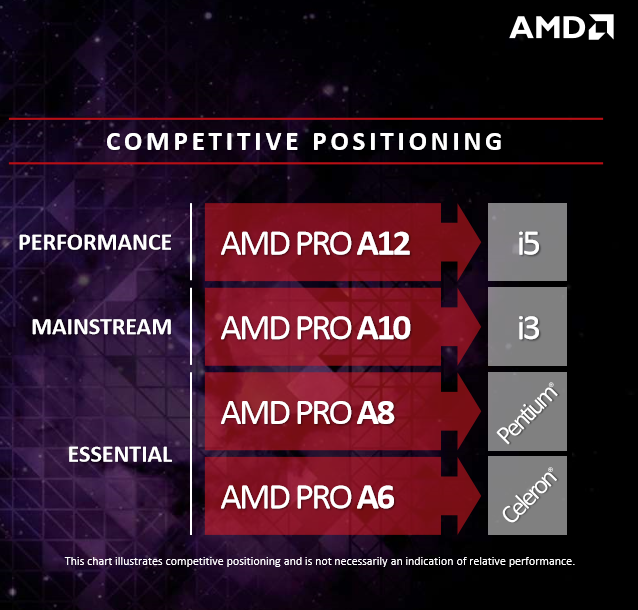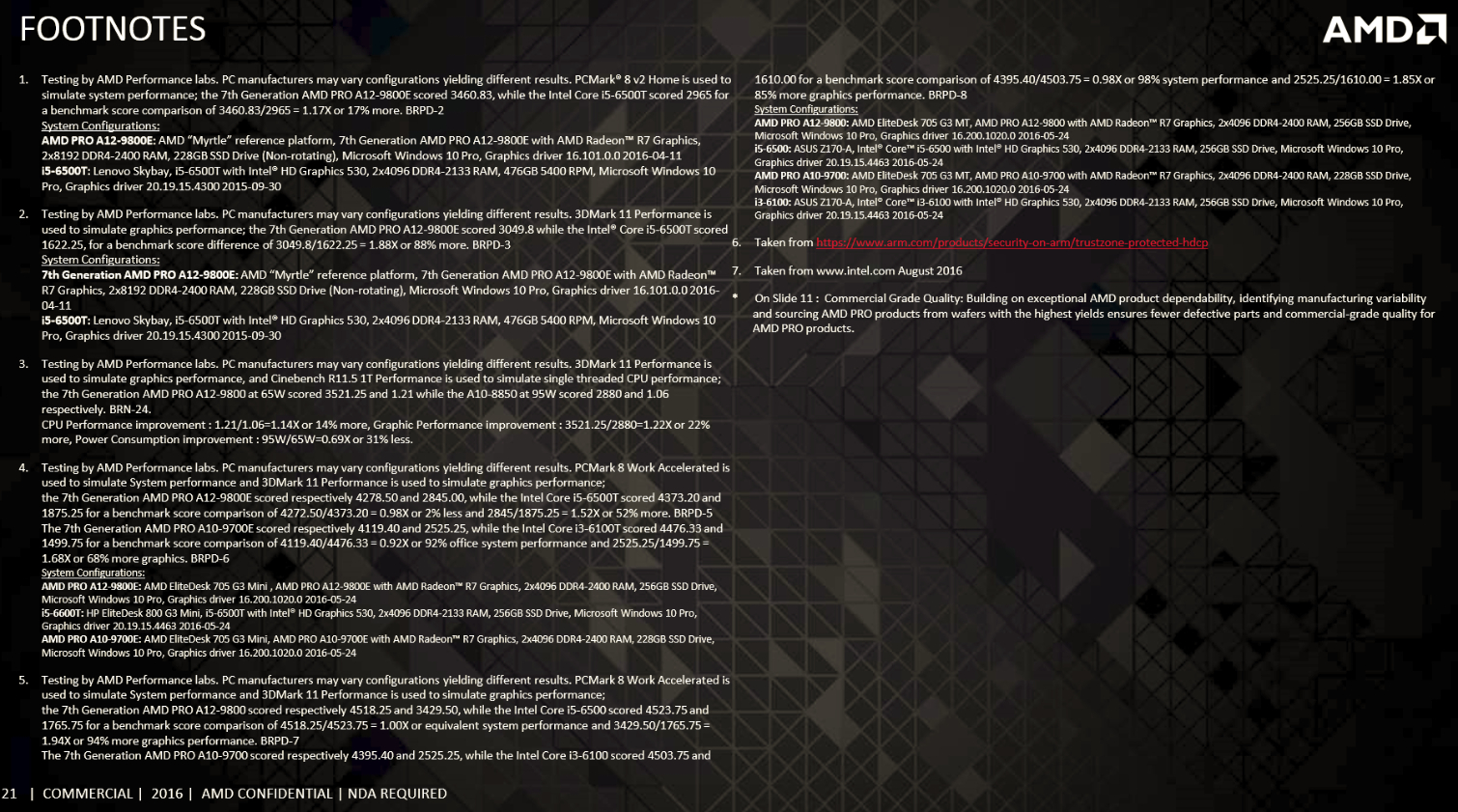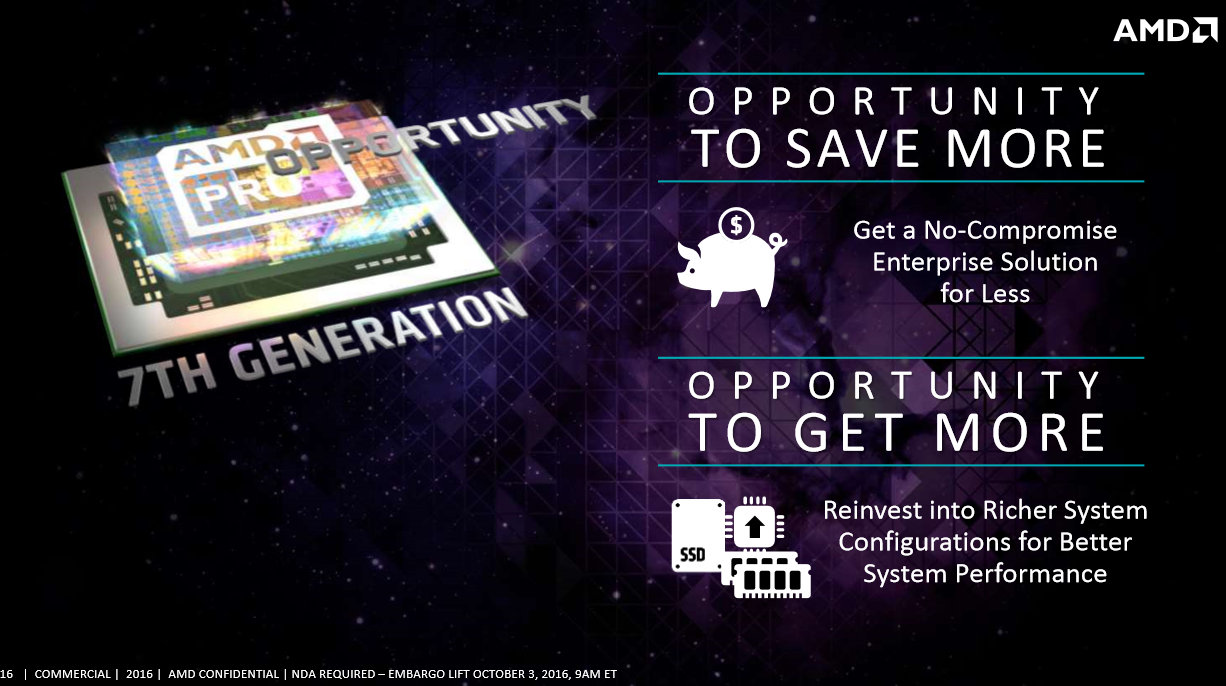AMD Launches 7th Generation Bristol Ridge PRO APUs
AMD announced its 7th Generation Bristol and Stony Ridge processor earlier this year at Computex and followed up with the September announcement that HP and Lenovo are shipping Bristol Ridge APUs with the AM4 socket. As with any diverse product stack, AMD also offers products tailored specifically for commercial markets, and today's announcement outlines AMD's release of its new PRO APUs.
The AMD Bristol Ridge PRO (Performance, Reliability, Opportunity) Series leverages the AM4 chipset and focuses on performance, mainstream, and basic use-cases in traditional desktop applications. It also includes APUs for the ultra-small form factors that are enjoying increasing popularity in professional settings. AMD's PRO Series continues to gain traction in the commercial marketplace; the company claimed its shipments grew 45% since 2014, and with the Windows 10 upgrade cycle still in full swing, it will likely see that trend continue.
The Bristol Ridge PRO APUs share some similarities to the consumer-centric models, but AMD added features designed to tailor them for professional applications, such as out-of-band management, security, encryption, and virtualization functions. In contrast to many of the same features on Intel's platforms, AMD is leveraging open industry standards to reduce vendor lock-in, which has both upsides and downsides. AMD also provided performance data against competing Intel platforms. Let's dive in.
Overview
The Bristol Ridge PRO series utilizes AMD's Excavator CPU and GCN 3.0 (Graphics Core Next) cores with the updated 28nm process, which means the PRO APUs are not utilizing the much-anticipated Zen 14nm cores. We can expect Zen-based APUs in the future, though, as the cores scale to every facet of AMD's stack. AMD is focusing on bringing the Zen-powered desktop Summit Ridge SKUs to market first, and the recent Bristol and Stony Ridge launches suggest it will be quite some time before Zen-infused APUs come to market.
AMD stratified the PRO series into 65W TDP SKUs for desktop applications and 35W SKUs for small form factor machines. The APUs will come to market through various OEMs, such as HP, which we will discuss later. The move up to the AM4 chipset brings the goodness of DDR4, PCIe 3.0, USB 3.1 Gen2 Type C, M.2 SSD connections, and AMD secure processor support to bear. EDIT: 10/4/16 - AMD responded to our chipset questions. The 65W PRO series will primarily use the B350 chipset, and the uSFF (35W) models will employ the B300 chipset.
Bristol Ridge PRO For Desktops
AMD offers 65W desktop variants with A12, A10, A8, and A6 SKUs. With the exception of the dual-core A6 variants, all of the desktop APUs feature four cores and four threads. AMD provided a list of Intel products that it deems to be direct competitors to its PRO series products, and we provide comparative data in the tables. AMD's A6-9500 PRO competes against the breadth of Intel's Celeron product stack.
| Desktop 7th Generation AMD Bristol Ridge PRO APUs | AMD A12-9800 PRO | Intel i5-6500 | AMD A10-9700 PRO | Intel i3-6100 | AMD A8-9600 PRO | Pentium G4400 | AMD A6-9500 PRO |
|---|---|---|---|---|---|---|---|
| Target Segment | Performance | Performance | Mainstream | Mainstream | Mainstream | Mainstream | Basic |
| Process | 28nm | 14nm | 28nm | 14nm | 28nm | 14nm | 28nm |
| CPU Cores/ Threads | 4 / 4 | 4 / 4 | 4 / 4 | 2 / 4 | 4 / 4 | 2 | 2 |
| Max/Base CPU Frequency (GHz) | 4.2 / 3.8 | 3.6 / 3.2 | 3.8 / 3.5 | 3.7 / - | 3.4 / 3.1 | 3.3 / - | 3.8 / 3.5 |
| Cache | 2MB | 6MB | 2MB | 3MB | 2MB | 3MB | 1MB |
| Graphics | Radeon R7 | HD Graphics 530 | Radeon R7 | HD Graphics 530 | Radeon R7 | HD Graphics 510 | Radeon R5 |
| GPU CUs/Stream Processors | 8 / 512 | 24 EU | 6 / 384 | 24 EU | 6 / 384 | 12 EU | 6 / 384 |
| GPU MHz | 1108 (max) | 350 /1050 | 1029 (max) | 350 /1050 | 900 (max) | 350 / 1000 | 1029 (max) |
| Default TDP | 65W | 65W | 65W | 51W | 65W | 54W | 65W |
| cTDP Range (W) | N/A | ? | 45 - 65 | ? | 45 -65 | ? | 45 - 65 |
| Memory | DDR4-2400 | DDR4-2133 | DDR4-2400 | DDR4-2133 | DDR4-2400 | DDR4-2133 | DDR4-2400 |
The Bristol Ridge Pro Series, for both desktop and small form factors, offers a configurable TDP (cTDP) range that allows vendors to tailor the device for specific power and thermal envelopes (noted in the table). The high-end A12-9800 and A12-9800E (below) PRO don't have a cTDP feature. Some Intel CPUs, such as its Kaby Lake range, allow vendors to configure the TDP above the base configuration (for instance, a 15W processor can run at 25W), but AMD restricts the cTDP ceiling for its 65W models to the base configuration (i.e., vendors can adjust only to lower values).
Get Tom's Hardware's best news and in-depth reviews, straight to your inbox.
The A12 model features 12 cores (4 CPU + 8 GPU), whereas the A10 features 10 cores, and so on. The A12-9800 is the first A12 model for the PRO market, and it features an aggressive 1GHz advantage in top CPU speed compared to its Intel counterpart, whereas the remainder of the series offers conservative maximum speed gains. The Intel Core i3 and Pentium models do not have TurboBoost functionality, but the competing AMD models feature Turbo Core. The lower base AMD clocks could lead to additional power savings during less intense workloads.
AMD's GCN 3.0 Radeon R7 cores compete against Intel's HD Graphics 530, and the Radeon R5 squares up against the HD Graphics 510 offerings. Of course, AMD provided head-to-head graphics performance comparisons for a few SKUs, which we will cover shortly. Intel lists both the base and maximum clock of its GPU offerings, whereas AMD provided only the maximum performance speeds.
Bristol Ridge PRO For Small Form Factors
AMD's "E" PRO series targets the small form factor (SFF) and uSFF (ultra SFF) space, which the company contends is the fastest growing segment. The "E" indicates that the APU features a 35W TDP. The E models also sport GCN 3.0 cores and Radeon R7 and R5 graphics. The A8-9800E leads the pack with 4 CPU cores and a top speed of 3.8GHz.
| Small Form Factor 7th Generation AMD Bristol Ridge PRO APUs | AMD A12-9800E PRO | Intel i5-6500T | AMD A10-9700E PRO | Intel i3-6300T | AMD A8-9500E PRO | i3-6100T |
|---|---|---|---|---|---|---|
| Target Segment | Performance | Performance | Mainstream | Mainstream | Mainstream | Mainstream |
| Process | 28nm | 14nm | 28nm | 14nm | 28nm | 14nm |
| CPU Cores/ Threads | 4 /4 | 4 / 4 | 4 /4 | 2 / 4 | 2 | 2 / 4 |
| Max/Base CPU Frequency (GHz) | 3.8 / 3.1 | 2.5 / 3.1 | 3.5 / 3.0 | 3.3 / - | 3.4 / 3.0 | 3.2 / - |
| Cache | 2MB | 6MB | 2MB | 4MB | 1MB | 3MB |
| Graphics | Radeon R7 | HD Graphics 530 | Radeon R7 | HD Graphics 530 | Radeon R5 | HD Graphics 530 |
| GPU CUs/Stream Processors | 8 / 512 | 24 EU | 6 / 384 | 24 EU | 4 / 256 | 24 EU |
| GPU MHz | 900 (max) | 350 /1100 | 1029 (max) | 350 /950 | 800 (max) | 350 / 950 |
| Default TDP | 35W | 35W | 35W | 35W | 35W | 35W |
| cTDP Range (W) | N/A | ? | 25 - 45 | ? | 25 -45 | ? |
| Memory | DDR4-2400 | DDR4-2133 | DDR4-2400 | DDR4-2133 | DDR4-2400 | DDR4-2133 |
The 35W PRO series, like the 65W desktop versions, support dual-channel DDR4-2400, whereas Intel tops out at DDR4-2133. The A10-9700E and A8-9500E models feature a cTDP range that extends up to 45W, which is above the 35W base TDP setting. OEM 1-litre uSFF systems have very strict thermal limits, so AMD's focus on power efficiency and cTDP envelopes will have a big impact in the diminutive segment.
Interestingly, all of the 6th Generation products were BGA-mounted, which completely removes the possibility of future processor upgrades. By contrast, the 7th Generation products are all socketed processors that will allow businesses to upgrade their kit in the future. The PRO platform utilizes the AM4 socket, so there is a possibility that users could upgrade to Zen processors in the future. However, AMD is not guaranteeing that functionality at this time, and a Zen upgrade path would likely hinge on an OEM BIOS update. In either case, it is rational to expect Zen upgradeability for 7th-Gen platforms.
The Competitive Landscape And Performance Claims
The AMD PRO A12 lines up against Intel Core i5 products, the A10 tackles Core i3, and the A8 and A6 models address the Pentium and Celeron chips, respectively.
AMD provided performance data against competing products, but as with any vendor-supplied metrics, we have to caution that AMD based the values on its own internal lab testing.
AMD noted that the upper end of its clock speeds reaches up to 4.2GHz for the 65W models and 3.8GHz for 35W "E" models. AMD claimed the A12-9800E offers up to 17% more system performance than the competing Core i5. AMD measured performance with the PCMark 8 v2 Home benchmark, but according to AMD's test notes (which we've included below for your perusal), the AMD and Intel test platforms weren't entirely evenly matched.
The PCMark 8 tests consist of several subtests, and Futuremark's documentation stated that the Web Browsing tests stress the storage subsystem, which means the workload would likely benefit from a faster drive. The Lenovo Skybay Intel i5-6500T comparison system featured a 476GB 5,400 RPM HDD, whereas AMD outfitted its Bristol Ridge "Myrtle" reference platform with a 228GB SSD. Also, the AMD system featured 2x8192 DDR4-2400MHz RAM, but the Intel system had only 2x4096 DDR4-2133MHz RAM.
The uneven test platforms highlight the difference between pre-configured systems, and the comparison makes sense because most commercial systems will come as a full solution. However, the test results do not provide much visibility into a more direct processor comparison.
AMD also used the same platforms to measure graphics performance with the 3DMark 11 Performance test, which indicated the A12-9800E offers 88% more graphics performance than the Intel Core i5-6500T.

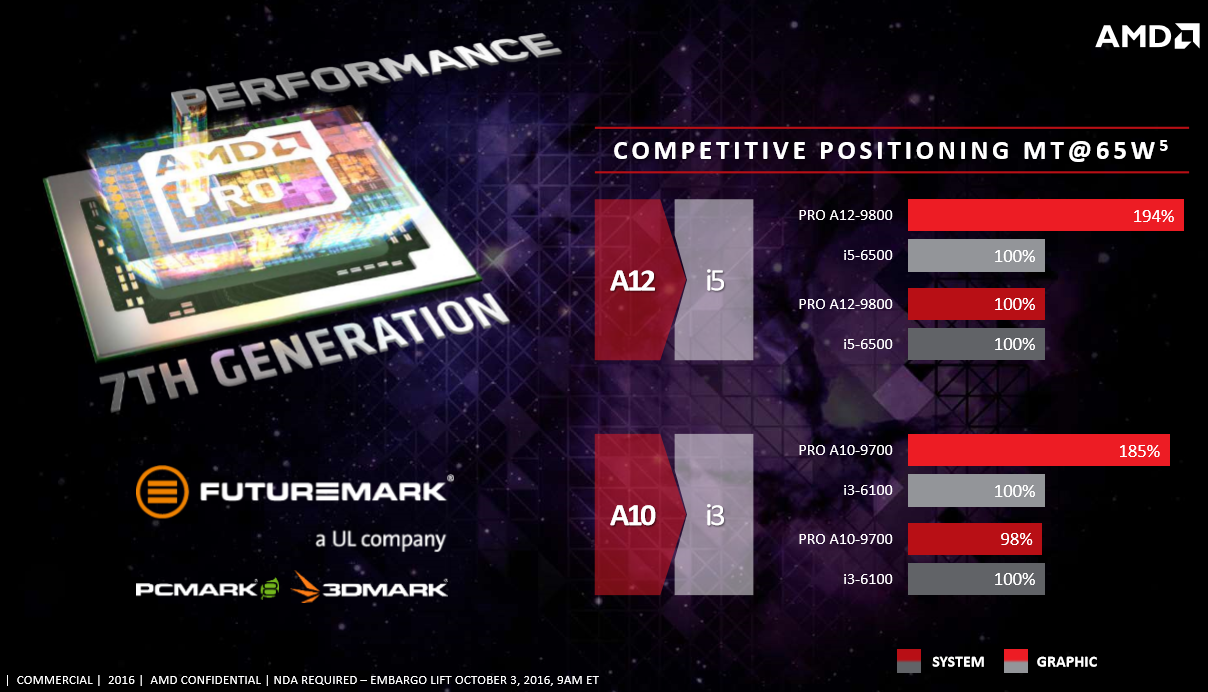

The comparative platforms were more evenly matched during the 65W and 35W tests. Both systems employed SSDs and the same 8GB of RAM, though the AMD platform did use 2400MHz RAM, whereas Intel employed its maximum speed of 2133MHz.
The 65W results pit the A12 against a Core i5-6500, and AMD's results indicate the A12-9800 offers a 94% advantage in graphics performance (3DMark 11 Performance) and equal system/productivity performance (PCMark 8 Work Accelerated). AMD also conducted a test with the A10-9700 against the Core i3-6100 with comparable systems. AMD's results indicate that the A10-9700 offers 85% more graphics performance and slightly less (-2%) system performance with the same workloads.
AMD also provided benchmark results from the 35W A12-9800E against the i5-6500T, which highlighted a reported 52% increase in graphics performance and -2% system performance. The A10-9700E showed a 68% graphics improvement over the i3-6100T, and -8% system performance.
Commercial-Centric Feature Set
Commercial users in professional environments have a different set of needs than typical consumers. Both AMD and Intel have a wide range of commercial-specific features that tailor their products for end users. The most pressing issue for most enterprises is longevity and reliability; bear in mind that many businesses are still on Windows XP. AMD provides 18 months of image stability, 24 months of product longevity, and an (up to) 3-year processor warranty.

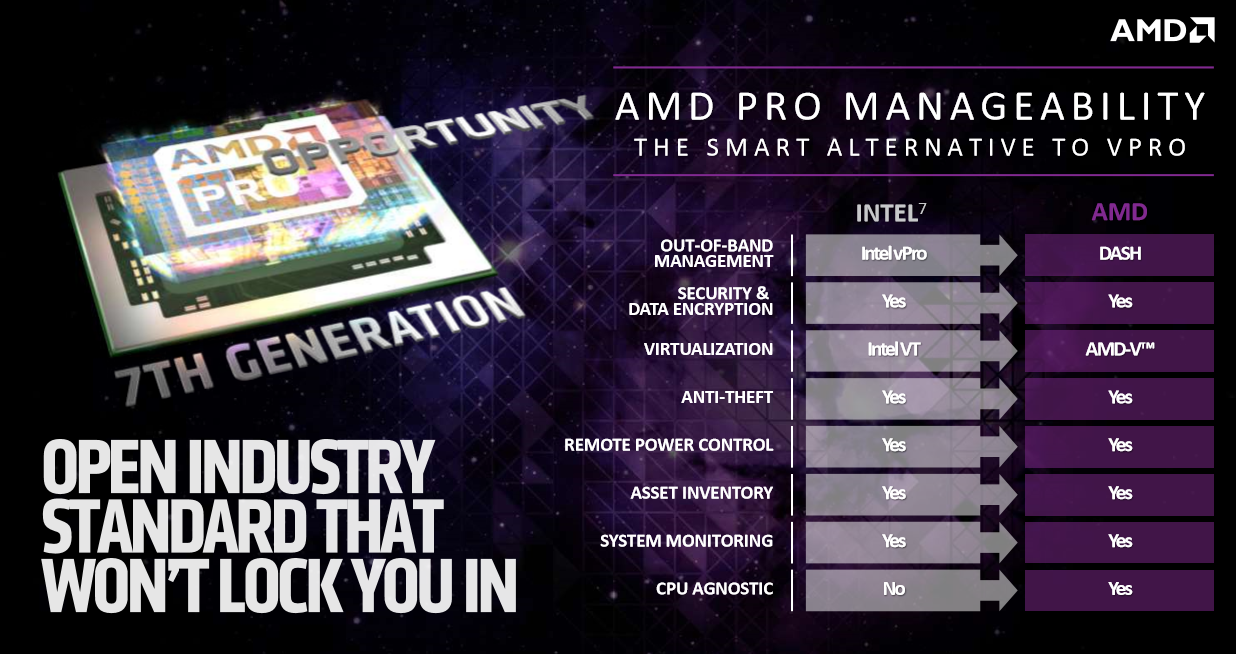
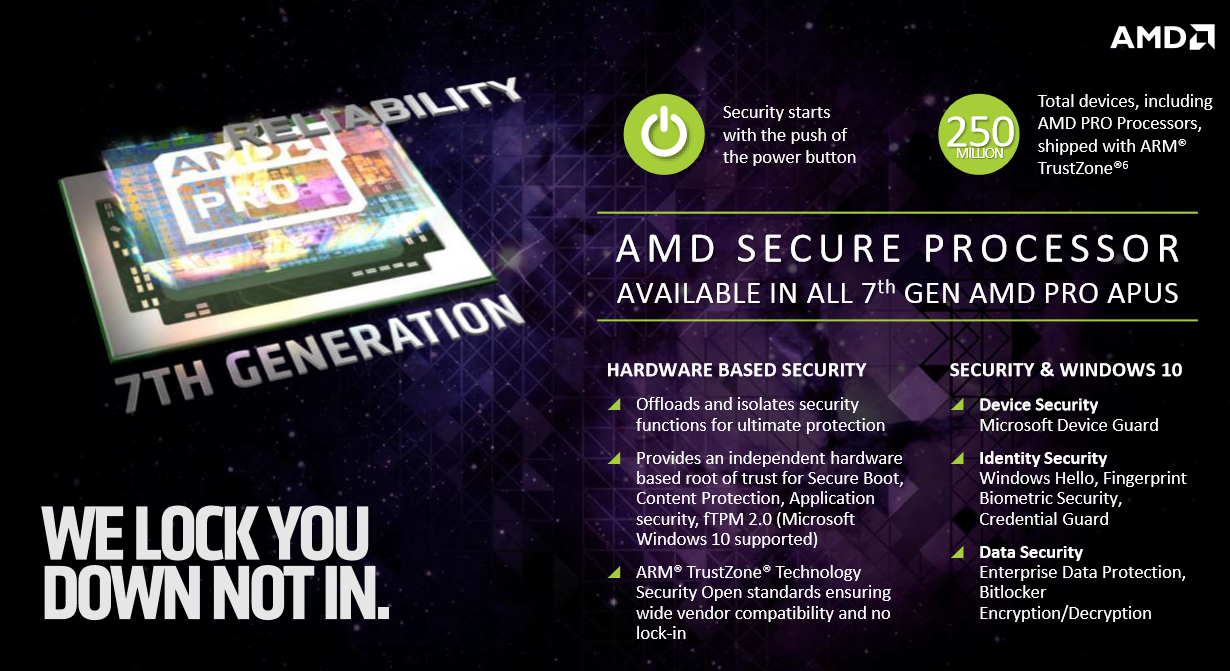
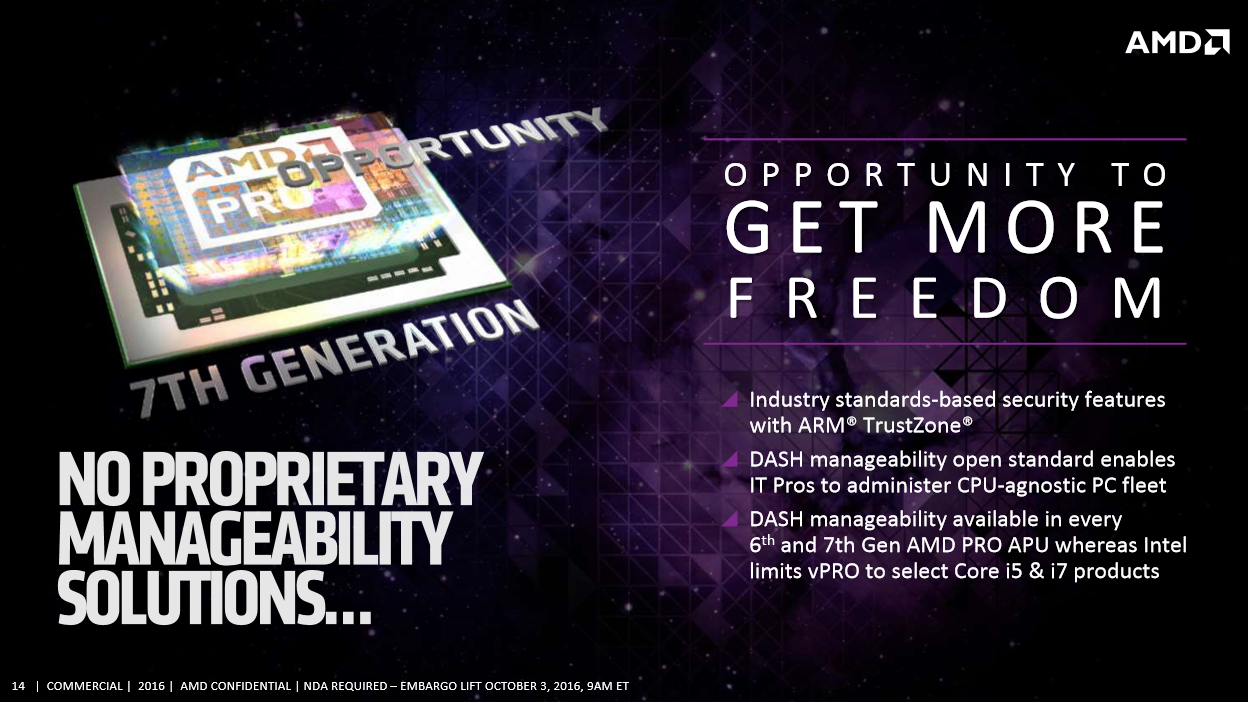
AMD is rather proud of its stable of Open Standards-based technologies, and the company is quick to point out that Intel utilizes mostly proprietary technology to achieve the same goals. Using proprietary technology is a negative in many situations, as an organization can fall into the "vendor lock-in" trap when it standardizes on a single platform. Being bound to a single vendor can be a bad situation for long-term deployments. However, a benefit of leveraging proprietary solutions boils down to the "one throat to choke" service model. This means that the vendor cannot shift the blame to another entity when a problem arises, which can eliminate service bottlenecks.
Both approaches have advantages, but AMD prefers the standards-based ARM TrustZone and the open standard DASH manageability suite. A key differentiation is that DASH manageability is available for all 6th- and 7th-generation AMD PRO APUs, whereas Intel restricts its competitive security suite to certain Core i5 and i7 products. The ARM TrustZone runs on an integrated co-processor that handles hardware-driven security-related tasks (a first for the PRO desktop products).
AMD designed its Secure Processor technology to envelop the user in security from boot up to power down. AMD focused on tight integration with Windows 10 security features. The protection begins during the boot process with Secure Boot, Consistent Protection, application security, and fTPM 2.0. The suite also supports Microsoft Security Guard, Windows Hello, biometric security, Credential Guard and BitLocker.
25X20 Energy Focus
AMD's focus on its 25X20 initiative, in which it aims to reduce power consumption by 25x by 2020, continues unabated with the Pro Series.
AMD measured this batch of 6th Generation versus 7th Generation results with 3DMark 11 Performance for graphics and Cinebench R11.5 1T Performance for single-threaded CPU performance. The big difference between the AMD test platforms comes down to TDP. The previous-gen A10-8850 Godavari is a 95W model, but the new Bristol Ridge A12-9800 is only 65W.
AMD measured a 14% increase in CPU performance, 22% increase in graphics performance, and a 32% reduction in power consumption. Overall, these are impressive results; AMD managed to wring out a sizeable amount of performance and efficiency gains within a much lower TDP envelope.
AMD has traditionally been the low-priced alternative to Intel products, and as such, the company is promoting its "get more" messaging with its Pro series. AMD contends that the lower price structure allows its customers to spend more money on upgrades, such as more RAM or better displays, due to the lower overall price of its APUs. AMD hasn't released PRO pricing guidelines as of yet, but we expect it to be very competitive with competing Intel products.
Leading-Edge HP Products
The professional segment tends to buy its products as full systems, as opposed to the component-level purchasing found in the broader retail desktop market. The nature of the commercial marketplaces places much more emphasis on OEM partners and system integrators that provide system-level products.
AMD announced that HP would bring forward its new EliteDesk 705 G3 models, which will come in mini (35W), small form factor, and mini-tower (65W) designs. We do not have specific system specifications at the time of writing, but we will update the article as required.
HP is leading the 7th generation PRO series charge, but AMD noted it isn't limited to one partner. The company expects to announce more partners in the coming weeks.
Into The Market
The AMD 7th Generation Bristol Ridge PRO Series APUs are available now, and we will share pricing and partner information as more becomes available. AMD's PRO series is a much-needed step in the right direction as it continues to battle against Intel in the broad computing market.
The commercial space is steadily growing as companys transition to newer Windows 10 platforms. Most IT departments wait for major OS upgrades, such as the new Windows 10 builds (which are the equivalent of service packs), before updating to newer versions. The migration to Windows 10 professional platforms is well underway, which promises robust sales, so AMD's Bristol Ridge timing is good.
AMD has enjoyed some amount of financial success recently, and it has already seen a 45% increase in shipments of its PRO platforms. If the 7th Generation products prove to be competitive from a performance standpoint, it could snap up even more share. Most businesses are keen to reduce overall spending, so AMD's pricing will play a key role. Of course, OEM partners and system integrators also play an important role in the commercial segment, and for now, AMD has a somewhat limited number of systems hitting the market. AMD expects the number of systems to accelerate in the near future.
AMD's decision to deploy the AM4 platform with socketed APUs is a step towards offering its customers forward-looking systems that they can use to upgrade to the (frankly) more interesting Zen products in the future.

Paul Alcorn is the Editor-in-Chief for Tom's Hardware US. He also writes news and reviews on CPUs, storage, and enterprise hardware.
-
Atom Symbol The marketing slides are lying about the relative x86 performance of A12-9800 compared to i5-6500 - independent benchmarks are going to show that i5-6500 generally executes more x86 instructions per second than A12-9800.Reply -
gnarr Now I want benchmarks.. Which are more powerful for each ATi Radeon 9x00 Pro vs AMD 9x00 Pro ;)Reply -
timtiminhouston If the OEMs pack the machines with crippled performance motherboards like the first HP AM4 motherboard the performance will suck even worse. I have worked on three recent AMD laptops that were fit only for a landfill because they were restricted to single channel memory, no matter how much memory you put in. I benchmarked all three machines and they all suffered more than a 50% performance penalty from their advertised specs because the single channel memory. My father-in-law's laptop with an A8 was unable to open MS Word faster than a 3.2 Ghz P4-HT Dell Desktop (Windows 7 vs Windows 10 so not exact comparison) same father-in-law has. He thought there was something wrong because his "new" $350 laptop could not keep up with the old desktop I gave him. I could not believe he was so stupid as to buy without asking me first, but whatever, he got used to the lag. And it lags bad, as in click, wait 5-6 seconds, and then something happens, then click again. I would pull my hair out if I had to work on that.Reply -
Paul Alcorn Reply18679171 said:"AMD provides 18 months of image stability" What does that even mean?
Basically, it means that the components and drivers won't change over the defined period of time. This minimizes IT overhead for qualifying/deploying new images, etc. So the business makes images of systems, then just flings them around wherever needed when they deploy new systems. However, if there are driver/component changes an image won't work on another system.
"A consistent and key condition for the commercial market is disk image stability which allows IT organizations to focus on supporting a single, stable platform, reducing the number of disk images, and in turn, helping to reduce overall IT support costs. With disk image stability, businesses can create and maintain a standardized software image consisting of hardware drivers, application software and an operating system. This software image can then be applied when new PCs are deployed without the concern of incompatibilities between hardware and software." -- http://www.businesswire.com/news/home/20050926006172/en/AMD-Introduces-Commercial-Stable-Image-Platform-Program -
nycalex AMD releasing subpar garbage since 2009. what a joke. i'll stay with intel all day.Reply
come on AMD show me some high end stuff! -
rush21hit All of that stuff crammed on the A12 while stays at 35watt TDP package impress me. I remember HD7750 that also has the same number of SP hovers at 60-65C.Reply
Alas, its only on newer platform. I would want it to exist at FM2+ too. -
blazorthon Reply18679446 said:AMD releasing subpar garbage since 2009. what a joke. i'll stay with intel all day.
come on AMD show me some high end stuff!
Actually, Excavator is pretty decent and not that old. It is a far cry from the other Bulldozer variants regarding performance per Hz and power efficiency. While it would've been nice to see Zen, Excavator with a platform upgrade is a good way of getting AM4 started. The more things you have already tested when you bring out Zen, the fewer things that are likely to go wrong.
-
turkey3_scratch I can never understand or keep track of AMDs CPU naming schemes to this day I am still lost; I wish they were as simple as Intel's.Reply

